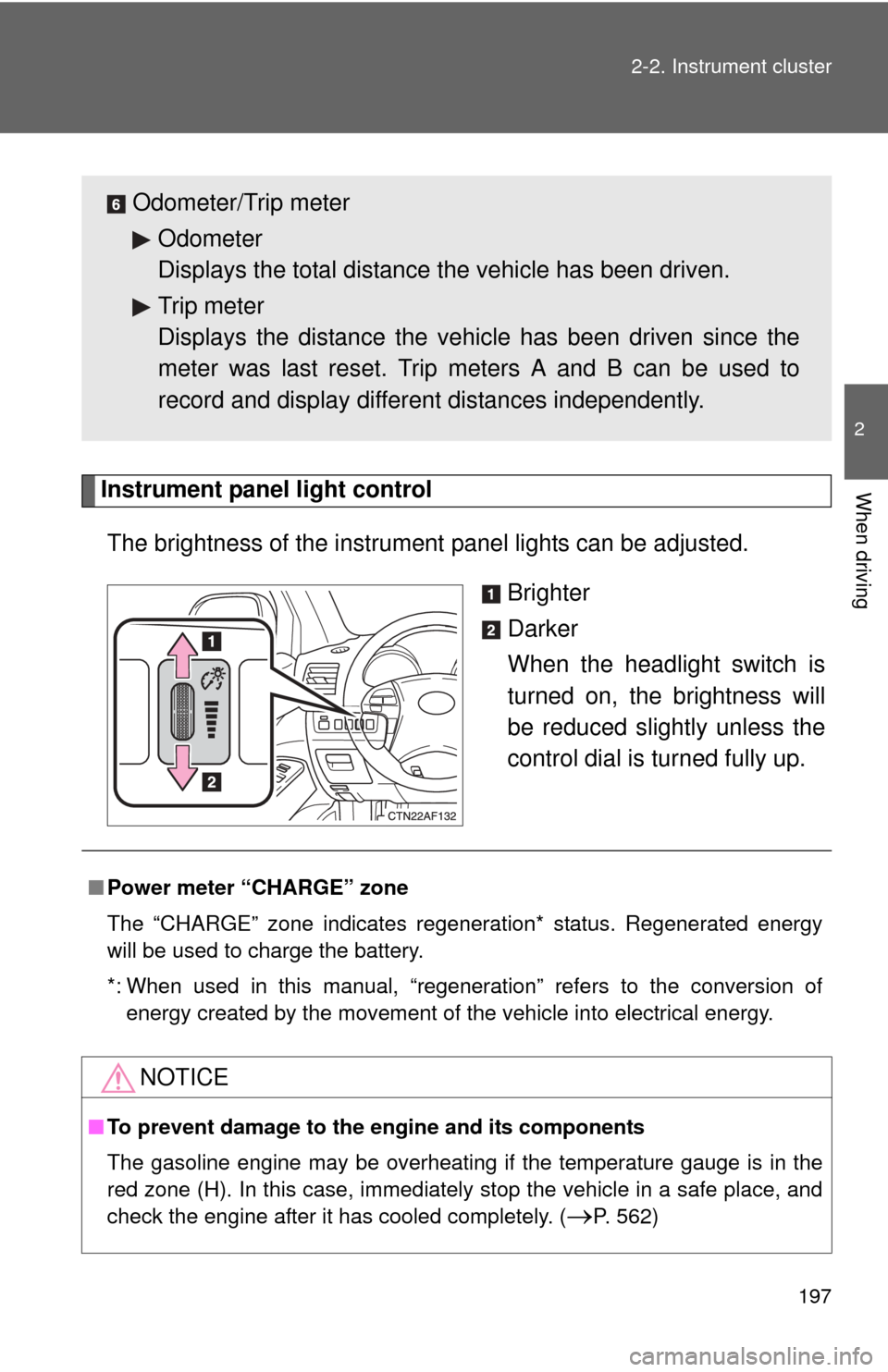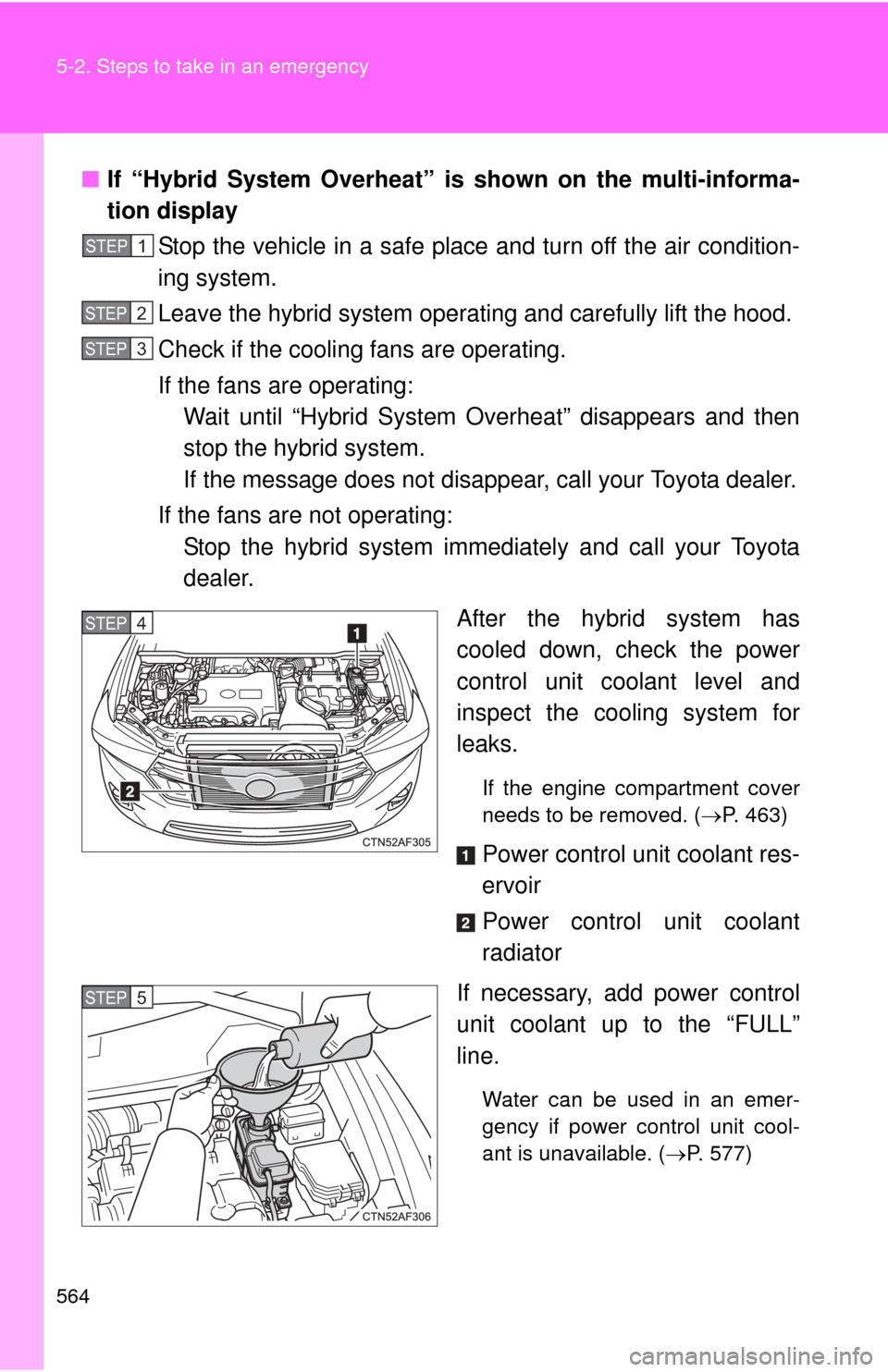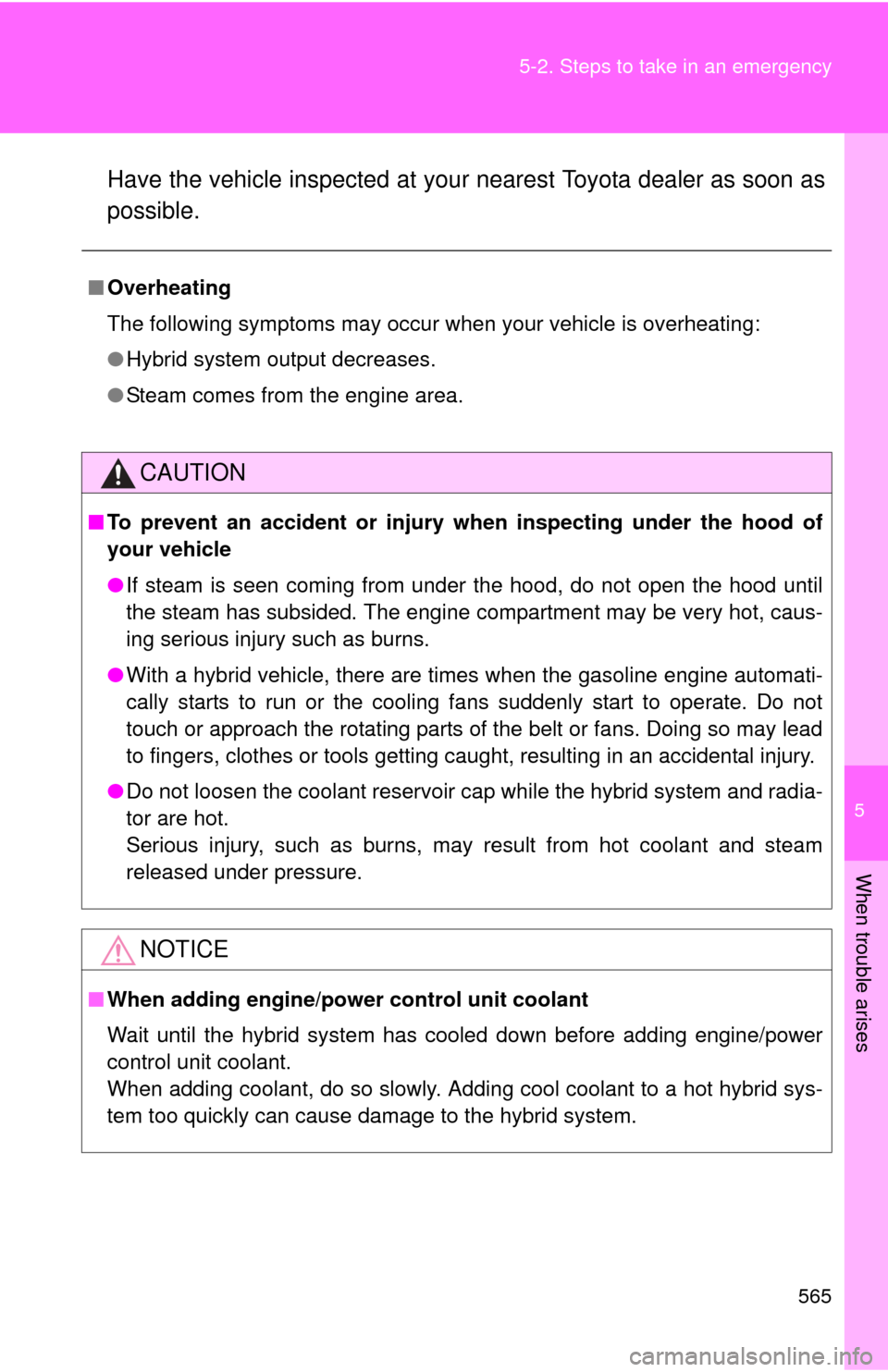engine overheat TOYOTA HIGHLANDER HYBRID 2012 XU40 / 2.G Owners Manual
[x] Cancel search | Manufacturer: TOYOTA, Model Year: 2012, Model line: HIGHLANDER HYBRID, Model: TOYOTA HIGHLANDER HYBRID 2012 XU40 / 2.GPages: 636, PDF Size: 11.26 MB
Page 5 of 636

1
2
3
4
5
6
7
5
4-1. Maintenance and careCleaning and protecting the vehicle exterior............ 442
Cleaning and protecting the vehicle interior............. 445
4-2. Maintenance Maintenance requirements ..................... 448
General maintenance.......... 450
Emission inspection and maintenance (I/M)
programs........................... 453
4-3. Do-it-yourself maintenance Do-it-yourself service precautions ....................... 454
Hood ................................... 458
Positioning a floor jack ........ 460
Engine compartment ........... 462
12-volt battery ..................... 473
Tires .................................... 477
Tire inflation pressure ......... 485
Wheels ................................ 488
Air conditioning filter............ 491
Wireless remote control/ electronic key battery ........ 494
Checking and replacing fuses ................................. 497
Light bulbs........................... 510 5-1. Essential information
Emergency flashers............ 520
If your vehicle needs to be towed........................... 521
If you think something is wrong ............................ 527
5-2. Steps to take in an emergency
If a warning light turns on or a warning buzzer
sounds... .......................... 528
If a warning message is displayed .......................... 538
If you have a flat tire ........... 539
If the hybrid system will not start ............................ 552
If the shift lever cannot be shifted from P ................... 554
If you lose your keys/ wireless remote control
transmitter ........................ 555
If the electronic key does not operate properly ......... 556
If the 12-volt battery is discharged........................ 558
If your vehicle overheats .... 562
If the vehicle becomes stuck ................................. 566
If your vehicle has to be stopped in an
emergency ....................... 567
4Maintenance and care5When trouble arises
Page 173 of 636

173
2-1. Driving procedures
2
When driving
CAUTION
●
Do not shift the shift lever to P while the vehicle is moving.
Doing so can damage the transmission and may result in a loss of vehicle\
control.
● Do not shift the shift lever to R while the vehicle is moving forward.
Doing so can damage the transmission and may result in a loss of vehicle\
control.
● Do not shift the shift lever to D while the vehicle is moving backward.
Doing so can damage the transmission and may result in a loss of vehicle\
control.
● Moving the shift lever to N while the vehicle is moving will disengage the
hybrid system. Engine braking is not available with the hybrid system dis-
engaged.
● During normal driving, do not turn off the hybrid system. Turning the hybrid
system off while driving will not cause loss of steering or braking control,
but the power assist to these systems will be lost. This will make it more
difficult to steer and brake, so you should pull over and stop the vehicle as
soon as it is safe to do so.
However, in the event of an emergency, such as if it becomes impossible
to stop the vehicle in the normal way: P. 567
● Use engine braking to maintain a safe speed when driving down a steep
hill.
Using the brakes continuously may cause the brakes to overheat and lose
effectiveness. ( P. 191)
● When stopped on an inclined surface, use the brake pedal and parking
brake to prevent the vehicle from rolling backward or forward and causing
an accident.
● Do not adjust the position of the steering wheel, the seat, or the inside or
outside rear view mirrors while driving.
Doing so may result in a loss of vehicle control that can cause accidents
that may result in death or serious injury.
● Always check that all passengers' arms, heads or other parts of their bod-
ies are not outside the vehicle, as this may result in death or serious injury.
Page 175 of 636

175
2-1. Driving procedures
2
When driving
CAUTION
●
Avoid revving or racing the engine.
Running the engine at high speed while the vehicle is stopped may cause
the exhaust system to overheat, which could result in a fire if combustible
material is nearby.
■ When the vehicle is parked
●Do not leave glasses, cigarette lighters, spray cans, or soft drink cans in
the vehicle when it is in the sun.
Doing so may result in the following.
• Gas may leak from a cigarette lighter or spray can, and may lead to a
fire.
• The temperature inside the vehicle may cause the plastic lenses and plastic material of eye glasses to deform or crack.
• Soft drink cans may fracture, causing the contents to spray over the interior of the vehicle, and may also cause a short circuit in the vehi-
cle's electrical components.
● Do not leave cigarette lighters in the vehicle. If a cigarette lighter is in a
place such as the glove box or on the floor, it may be lit accidentally when
luggage is loaded or the seat is adjusted, causing a fire.
● Do not attach adhesive discs to the windshield or windows. Do not place
containers such as air fresheners on the instrument panel or dashboard.
Adhesive discs or containers may act as lenses, causing a fire in the vehi-
cle.
● Do not leave a door or window open if the curved glass is coated with a
metallized film such as a silver-colored one. Reflected sunlight may cause
the glass to act as a lens, causing a fire.
● Always apply the parking brake, shift the shift lever to P, stop the hybrid
system and lock the vehicle.
Do not leave the vehicle unattended while the hybrid system is operating.
● Do not touch the exhaust pipe while the hybrid system is operating or
immediately after turning the hybrid system off.
Doing so may cause burns.
● Do not leave the hybrid system operating in an area with snow build-up, or
where it is snowing. If snowbanks build up around the vehicle while the
hybrid system is operating, exhaust gases may collect and enter the vehi-
cle. This may lead to death or a serious health hazard.
Page 187 of 636

187
2-1. Driving procedures
2
When driving
CAUTION
■
When starting the hybrid system
Always start the hybrid system while sitting in the driver's seat. Do not
depress the accelerator while starting the hybrid system under any circum-
stances.
Doing so may cause an accident resulting in death or serious injury.
■ Caution when driving
Do not turn the engine switch to the “LOCK” position while driving. If, in an
emergency, you must turn the hybrid system off while the vehicle is moving,
turn the key only to the “ACC” position.
NOTICE
■To prevent 12-volt battery discharge
Do not leave the key in the “ACC” or “ON” position for long periods without
the hybrid system on.
■ When starting the hybrid system
●Do not crank for more than 30 seconds at a time. This may overheat the
starter and wiring systems.
● Do not race a cold hybrid system.
● If the hybrid system becomes difficult to start or stalls frequently, have the
hybrid system checked immediately.
Page 197 of 636

197
2-2. Instrument cluster
2
When drivingInstrument panel light control
The brightness of the instrument panel lights can be adjusted.
Brighter
Darker
When the headlight switch is
turned on, the brightness will
be reduced slightly unless the
control dial is turned fully up.
Odometer/Trip meterOdometer
Displays the total distance the vehicle has been driven.
Trip meter
Displays the distance the vehi cle has been driven since the
meter was last reset. Trip meters A and B can be used to
record and display different distances independently.
■ Power meter “CHARGE” zone
The “CHARGE” zone indicates regeneration* status. Regenerated energy
will be used to charge the battery.
*: When used in this manual, “regeneration” refers to the conversion of
energy created by the movement of the vehicle into electrical energy.
NOTICE
■To prevent damage to the engine and its components
The gasoline engine may be overheating if the temperature gauge is in the
red zone (H). In this case, immediately stop the vehicle in a safe place, and
check the engine after it has cooled completely. (
P. 562)
Page 266 of 636

266 2-5. Driving information
●Avoid jerky starts or sudden acceleration.
● Avoid jerky steering and sharp turns, and slow down before mak-
ing a turn.
● Note that when making a turn, th e trailer wheels will be closer than
the vehicle wheels to the inside of the turn. Compensate by making
a wider than normal turning radius.
● Slow down before making a turn, in cross winds, on wet or slippery
surfaces, etc.
Increasing vehicle speed c an destabilize the trailer.
● Take care when passing other v ehicles. Passing requires consider-
able distance. After passing a vehi cle, do not forget the length of
your trailer, and be sure you hav e plenty of room before changing
lanes.
● To maintain engine braking efficiency and charging system perfor-
mance when using engine braking, do not put the transmission in
D.
● Instability happens more frequently when descending steep or long
downhill grades. Before descending, slow down and downshift. Do
not make sudden downshifts while descending steep or long down-
hill grades.
● Avoid holding the brake pedal down too long or applying the
brakes too frequently. This could cause the brakes to overheat and
result in reduced braking efficiency.
● Due to the added load of the trailer, your vehicle’s engine may
overheat on hot days (at temper atures over 85°F [30°C]) when
driving up a long or steep grade. If the engine coolant temperature
gauge indicates overheating, immediately turn off the air condition-
ing (if in use), pull your vehicle off the road and stop in a safe spot.
( P. 562)
Page 562 of 636

562
5-2. Steps to take in an emergency
If your vehicle overheats
Correction procedures■ If the needle of the engine coolant temperature gauge enters
the red zone
Stop the vehicle in a safe place and turn off the air condition-
ing system.
Check to see if steam is coming out from the engine area.
If you see steam:
Stop the hybrid system. Carefully lift the hood after the
steam subsides and then restart the hybrid system.
If you do not see steam: Leave the hybrid system operating and carefully lift the
hood.
Check if the cooling fans are operating.
If the fans are operating: Wait until the engine coolant temperature gauge begins to
fall and then stop the hybrid system.
If the fans are not operating: Stop the hybrid system immediately and call your Toyota
dealer.
The following may indicate that your vehicle is overheating:
●The needle of the engine coolant temperature gauge enters the
red zone:
The engine may be overheating.
● “Hybrid System Overheat” is shown on the multi-information dis-
play:
The power control unit may be overheating.
Follow the correction procedure as described below.
STEP1
STEP2
STEP3
Page 564 of 636

564 5-2. Steps to take in an emergency
■If “Hybrid System Overheat” is shown on the multi-informa-
tion display
Stop the vehicle in a safe place and turn off the air condition-
ing system.
Leave the hybrid system operating and carefully lift the hood.
Check if the cooling fans are operating.
If the fans are operating: Wait until “Hybrid System Overheat” disappears and then
stop the hybrid system.
If the message does not disapp ear, call your Toyota dealer.
If the fans are not operating: Stop the hybrid system immediately and call your Toyota
dealer.
After the hybrid system has
cooled down, check the power
control unit coolant level and
inspect the cooling system for
leaks.
If the engine compartment cover
needs to be removed. (P. 463)
Power control unit coolant res-
ervoir
Power control unit coolant
radiator
If necessary, add power control
unit coolant up to the “FULL”
line.
Water can be used in an emer-
gency if power control unit cool-
ant is unavailable. ( P. 577)
STEP1
STEP2
STEP3
STEP4
STEP5
Page 565 of 636

5
When trouble arises
565
5-2. Steps to take in an emergency
Have the vehicle inspected at your
nearest Toyota dealer as soon as
possible.
■ Overheating
The following symptoms may occur when your vehicle is overheating:
●Hybrid system output decreases.
● Steam comes from the engine area.
CAUTION
■To prevent an accident or injury when inspecting under the hood of
your vehicle
●If steam is seen coming from under the hood, do not open the hood until
the steam has subsided. The engine compartment may be very hot, caus-
ing serious injury such as burns.
● With a hybrid vehicle, there are times when the gasoline engine automati-
cally starts to run or the cooling fans suddenly start to operate. Do not
touch or approach the rotating parts of the belt or fans. Doing so may lead
to fingers, clothes or tools getting caught, resulting in an accidental injury.
● Do not loosen the coolant reservoir cap while the hybrid system and radia-
tor are hot.
Serious injury, such as burns, may result from hot coolant and steam
released under pressure.
NOTICE
■When adding engine/power control unit coolant
Wait until the hybrid system has cooled down before adding engine/power
control unit coolant.
When adding coolant, do so slowly. Adding cool coolant to a hot hybrid sys-
tem too quickly can cause damage to the hybrid system.
Page 625 of 636

625
Alphabetical index
Engine
Compartment........................ 462
Engine switch ............... 179, 184
Hood ..................................... 458
How to start the
hybrid system ..................... 179
Identification number ............ 571
If the hybrid system will not start .............................. 552
Ignition switch ............... 179, 184
Overheating .......................... 562
Power switch ........................ 179
Engine compartment cover .... 463
Engine coolan t temperature
gauge ..................................... 196
Engine oil Capacity ............................... 575
Checking .............................. 464
Preparing and checking before winter ...................... 251
Engine oil maintenance data ........................................ 448
Engine switch .................. 179, 184
Engine/power control unit
coolantCapacity ............................... 577
Checking .............................. 467
Preparing and checking before winter ...................... 251
EPS ........................................... 234
EV-Drive Mode ......................... 188
Event data recorder .................. 26 Floor mat...................................427
Fluid
Brake .....................................471
Washer ..................................472
Fog lights
Replacing light bulbs .............510
Switch....................................219
Wattage .................................583
Front automatic air conditioning system..............284
Front fog lights
Replacing light bulbs .............510
Switch....................................219
Wattage .................................583
Front manual air conditioning system..............278
Front passenger occupant
classification system ............145
Front passenger's seat belt reminder light.........................531
Front seats Adjustment ..............................83
Front side marker lights
Replacing light bulbs .............510
Switch....................................213
Wattage .................................583
Front turn signal lights Replacing light bulbs .............510
Wattage .................................583
Fuel Capacity ................................573
Fuel gauge ............................196
Gas station information .........636
Information ............................584
Refueling ...............................118
Type ......................................573
Fuel door...................................118
Fuel filler door ..........................118
Fuses.........................................497F